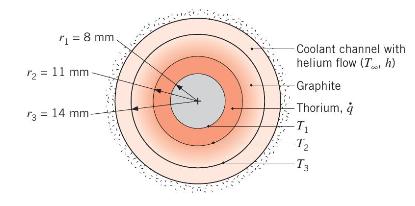A high-temperature, gas-cooled nuclear reactor consists of a composite cylindrical wall for which a thorium fuel element
Question:
A high-temperature, gas-cooled nuclear reactor consists of a composite cylindrical wall for which a thorium fuel element \((k \approx 57 \mathrm{~W} / \mathrm{m} \cdot \mathrm{K})\) is encased in graphite \((k \approx 3\) \(\mathrm{W} / \mathrm{m} \cdot \mathrm{K}\) ) and gaseous helium flows through an annular coolant channel. Consider conditions for which the helium temperature is \(T_{\infty}=600 \mathrm{~K}\) and the convection coefficient at the outer surface of the graphite is \(h=\) \(2000 \mathrm{~W} / \mathrm{m}^{2} \cdot \mathrm{K}\).

(a) If thermal energy is uniformly generated in the fuel element at a rate \(\dot{q}=10^{8} \mathrm{~W} / \mathrm{m}^{3}\), what are the temperatures \(T_{1}\) and \(T_{2}\) at the inner and outer surfaces, respectively, of the fuel element?
(b) Compute and plot the temperature distribution in the composite wall for selected values of \(\dot{q}\). What is the maximum allowable value of \(\dot{q}\) ?
Step by Step Answer:

Fundamentals Of Heat And Mass Transfer
ISBN: 9781119220442
8th Edition
Authors: Theodore L. Bergman, Adrienne S. Lavine




